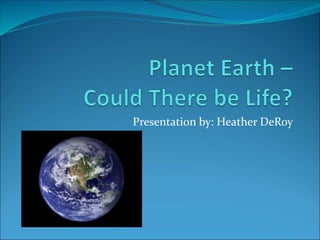
Earth (Edited).ppt
- 1. Presentation by: Heather DeRoy
- 2. Discovery of New Planet! Planet Earth, a part of a Solar System, is a possible candidate for life
- 3. Let’s investigate the location of planet Earth to see if it is a possible location for life to form!
- 4. Galactic Neighborhood Galactic environment impacts habitability Milky Way galaxy’s edge is a life- favorable spot Not near active gamma ray source Not near galactic center with high star density and ionizing radiation Loneliness in galaxy is helpful for life
- 5. The galactic neighborhood is good… let’s investigate the star it orbits!
- 6. Spectral Class of Star Needed for Life: Spectral class indicates photospheric temperature 7000K to 4000K Emit high-frequency UV radiation to trigger atmospheric ozone formation Emits not so much that ionization destroys life
- 7. Spectral Class of “Sun” Earth rotates around the star, the “Sun” Sun G2 star ~6,000K Sun is in “Habstar” range! Ozone can form in atmosphere Ionization is not deadly for life
- 8. Low Stellar Variation? All stars change luminosity Stars vary in stability… stars that fluctuate luminosity violently are poor candidates for hosting life The Sun is relatively stable! Solar variation is ~.1% over 11-year cycle Slight variations dramatically impact Earth Little Ice Age – decline in Sun’s luminosity
- 9. Now that we know the Sun star is a good candidate to support life, let’s look at planet Earth’s position relative to the Sun!
- 10. Habitable Zone Theoretical shell around a star where any planet present would have liquid water on its surface HZ range should not vary over time Stars increase luminosity as they age If this happens too quickly (super-massive star), planets are only in window for life for short amount of time Lowers time to develop life
- 11. Is Earth Located in Habitable Zone? Yes! Earth is located within the expected shell of distance in which liquid water can be on the surface of the planet! Pictures of the planet show liquid water covering a large portion of the Earth’s surface!
- 12. The relative position of Earth appears capable of supporting life… so let’s look at the planet itself!
- 13. Planet Characteristics that Support Life Terrestrial Silicate rocks Rocks not accreted to gaseous outer layers Gas Giants = no life No surface Enormous Gravity Satellites are good candidates, however
- 14. Composition of Earth? Earth is a terrestrial planet, not a gas giant
- 15. Mass of Planets need to be Just Right for Life Low Mass Bad news for life Lesser gravity – difficult for atmosphere retention Smaller planets lose energy from formation quickly geologically dead Approximately 0.3 Earth masses needed to sustain life
- 16. Mass of Earth High Mass Earth is largest by mass and density of terrestrial bodies in the Solar System Large enough for molten core (heat engine) Large enough for atmosphere through gravity Large enough for liquid outer core and metal inner core (magnetic field)
- 17. Magnetic Fields and Life Planets need protection from solar wind Solar wind- stream of charged particles from stars consisting of electrons and protons Planet must have molten metal interior
- 18. Does Earth have a Magnetic Field? Yes! Earth has solid metal core with liquid outer core, causing magnetic field Protects the Earth from solar wind
- 19. Atmosphere and Life Atmosphere – layer of gases that surround a material body of sufficient mass Held by gravity Helps regulate temperature Protects planet from meteors and radiation Composition favors life (oxygen and carbon dioxide)
- 20. Does Earth have an Atmosphere? Yes! Earth’s atmosphere is made up of Nitrogen (78%) Oxygen (20.9%) Argon (.93%) Carbon Dioxide (.0390%) This composition could support life Atmosphere absorbs/reflects harmful radiation Visible and Radio reach
- 21. Composition of Planets Four elements vital for life Carbon Hydrogen Oxygen Nitrogen
- 22. Earth’s Composition? Element oxygen alone found in Earth’s crust… However, other life elements are found in atmosphere and water Make amino acids (building blocks of protein) Comets and outgassing from volcanoes brought these elements
- 23. Tectonic Activity of Planet Supply surface with life-sustaining material Supply atmosphere with temperature moderators (CO2) Recycles important chemicals/materials Helps increase environmental complexity Earth is tectonically active!!
- 24. The planet Earth itself looks hopeful for supporting life… what about it’s orbit and rotation?
- 25. Life-Supporting Orbits Stability is critical Eccentricity Greater e, greater temperature fluctuation Living organisms can only withstand certain fluctuations Complex organisms have greater temperature sensitivity
- 26. Is Earth’s Orbit Suitable? Yes! Earth’s Orbit Almost circular E < .02
- 27. Life-Supporting Rotation Rotation around axis at tilt Planet should have moderate seasons or biospheric dynamism will disappear Without tilt, planet would be colder (warm weather could not move poleward) Should not be radically tilted because seasons would be extreme Speed of Rotation Should be relatively quick so day-night cycle is not too long (temperature differences if long days/nights)
- 28. Earth’s Rotation? Earth’s tilt varies between 21.5 and 24.5 degrees every 41,000 years Day is only 24 hours Moon plays crucial role Moderates Earth’s climate by stabilizing axial tilt
- 29. Earth COULD have life! Galactic Neighborhood Arm of Milky Way galaxy Star Spectral class G2 Low stellar variation Distance from Star Earth is located in Habitable Zone Liquid Water Composition/Size Terrestrial planet, relative high mass Magnetic Field Atmosphere Orbit Nearly circular Rotation Tilt allows seasons Short night/day
- 30. Now we need a closer look.